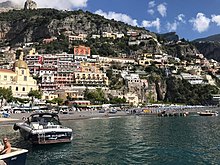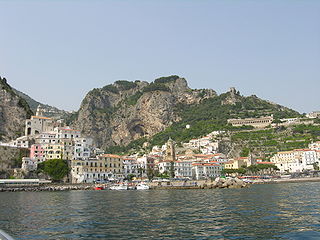
Amalfi is a town and comune in the province of Salerno, in the region of Campania, Italy, on the Gulf of Salerno. It lies at the mouth of a deep ravine, at the foot of Monte Cerreto, surrounded by dramatic cliffs and coastal scenery. The town of Amalfi was the capital of the maritime republic known as the Duchy of Amalfi, an important trading power in the Mediterranean between 839 and around 1200.

Sorrento is a town overlooking the Bay of Naples in Southern Italy. A popular tourist destination, Sorrento is located on the Sorrentine Peninsula at the south-eastern terminus of the Circumvesuviana rail line, within easy access from Naples and Pompei. The town is widely known for its small ceramics, lacework and marquetry (woodwork) shops.

Capri is an island located in the Tyrrhenian Sea off the Sorrento Peninsula, on the south side of the Gulf of Naples in the Campania region of Italy. The largest settlement on the island is the town of Capri. The island has been a resort since the time of the Roman Republic.

The Amalfi Coast is a stretch of coastline in southern Italy overlooking the Tyrrhenian Sea and the Gulf of Salerno. It is located south of the Sorrentine Peninsula and north of the Cilentan Coast.

Cava de' Tirreni is a city and comune in the region of Campania, Italy, in the province of Salerno, 10 kilometres northwest of the town of Salerno. It lies in a richly cultivated valley surrounded by wooded hills, and is a popular tourist resort. The abbey of La Trinità della Cava is located there.

Ravello is a town and comune situated above the Amalfi Coast in the province of Salerno, Campania, Southern Italy, with approximately 2,500 inhabitants. Its scenic location makes it a popular tourist destination, and earned it a listing as a UNESCO World Heritage Site in 1997.

Maiori is a town and comune on the Amalfi coast in the province of Salerno. It has been a popular tourist resort since Roman times, with the longest unbroken stretch of beach on the Amalfi coastline.

As one moves away from Naples in almost any direction, there is prominent musical activity to be found. These include, for example, the restoration and use of a number of the so-called "Vesuvian villas" in and near Ercolano, a string of once luxurious villas built in the 18th century and severely damaged by aerial bombardment in World War II. The most prominent of these is the Villa Campolieto, already restored, open and the site of chamber concerts by the Alessandro Scarlatti association.

Atrani is a city and comune on the Amalfi Coast in the province of Salerno in the Campania region of south-western Italy. It is located to the east of Amalfi, several minutes drive down the coast.

Castellabate is a town and comune in the province of Salerno in the Campania region of south-western Italy. It is one of I Borghi più belli d'Italia.
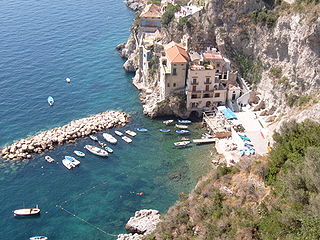
Conca dei Marini is a town and comune in the province of Salerno in the Campania region of south-western Italy. It is situated on a hill close to the coast and between Amalfi and Furore.
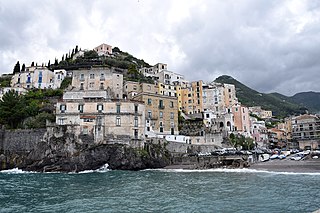
Minori is a comune in the province of Salerno, in the Campania region of south-western Italy. As a part of the Amalfi Coast, it was declared a UNESCO World Heritage Site in 1997.

Praiano is a town and comune of the province of Salerno in the Campania region of southwest Italy. It is situated on the Amalfi Coast, a prime tourist location for the region and Italy alike, between the towns of Amalfi and Positano.
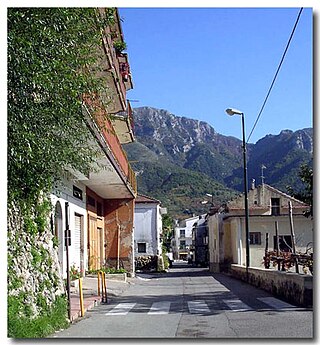
Tramonti is a town and comune in the province of Salerno in the Campania region of south-western Italy. It is located in the territory of the Amalfi Coast.

Scala is a town and comune in the province of Salerno in the Campania region of south-western Italy. It is located on a rocky hill c. 400 m above sea-level and is part of the Amalfi Coast.

The strada statale 163 Amalfitana, also known as Amalfi Drive, is a road which runs along the stretch of the Amalfi Coast between the southern Italian towns of Sorrento and Amalfi. The road was originally built by the Romans. The drive between Salerno, at the southern base of the peninsula, and Positano follows the coast for about 80 km (50 mi).

Villa Rufolo is a villa within the historic center of Ravello, a town in the province of Salerno, southern Italy, which overlooks the front of the cathedral square. The initial layout dates from the 13th century, with extensive remodeling in the 19th century.
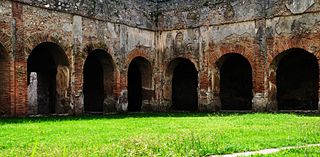
The Villa Romana or Roman Villa is an archaeological site dating from the 1st century in the Italian village of Minori, in Campania.
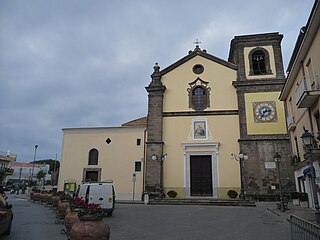
Sant'Agata sui Due Golfi is an Italian village, the major hamlet (frazione) of the municipality of Massa Lubrense in the Province of Naples, Campania region. It is part of the Sorrentine Peninsula and its population is around 3,000.

Il Gallo Lungo is an island of Italy, in Campania. Belonging to the municipality of Positano, it is part of the Li Galli group. It is the largest of the three islands of the group, with the shape of a long sickle, whose concavity, looking towards La Castelluccia and La Rotonda, defines a closed bay protected by other islets. On the convex side of Gallo Lungo, a small cove has been excavated, called "la Praja", with a very short beach, which allows boats to anchor. At the bottom of the cove there is a small house, while at the barren top of the island there is a coastal watchtower.





